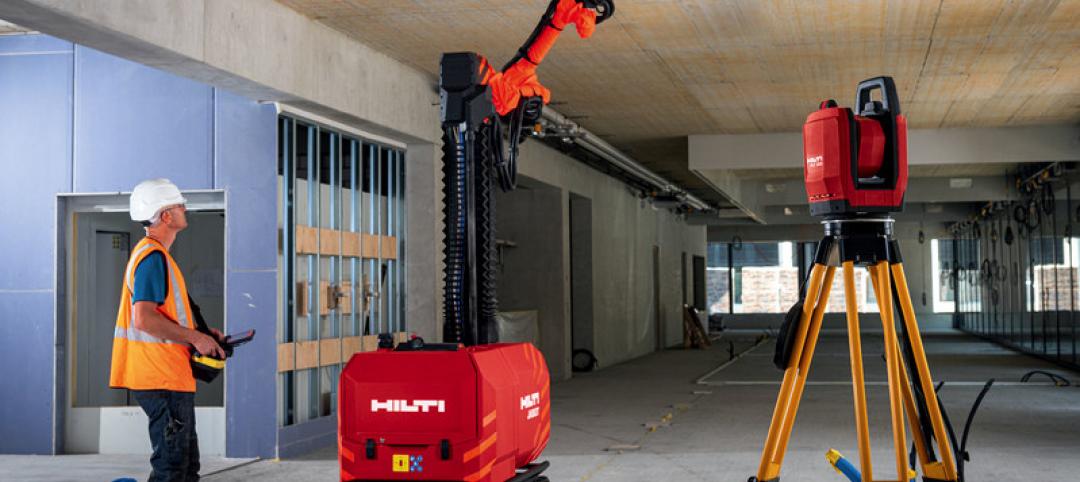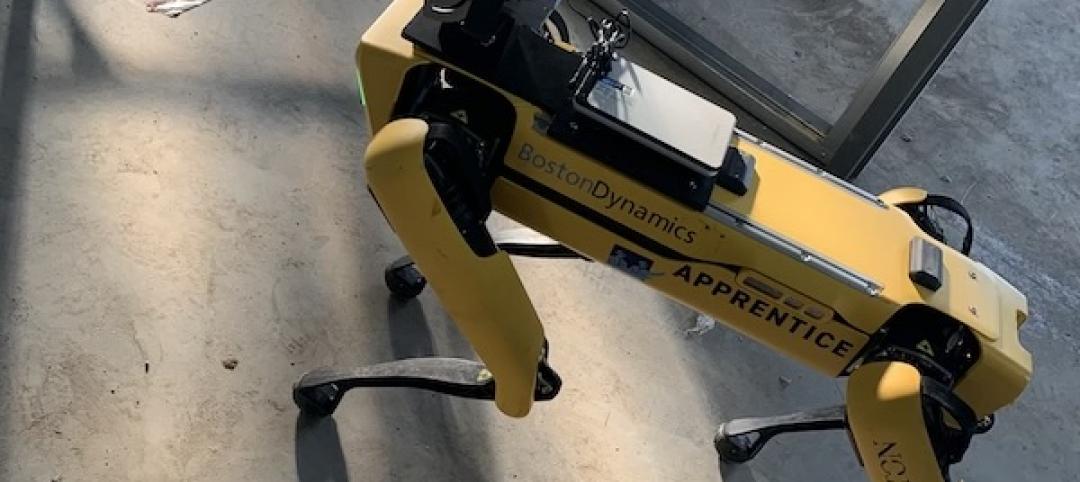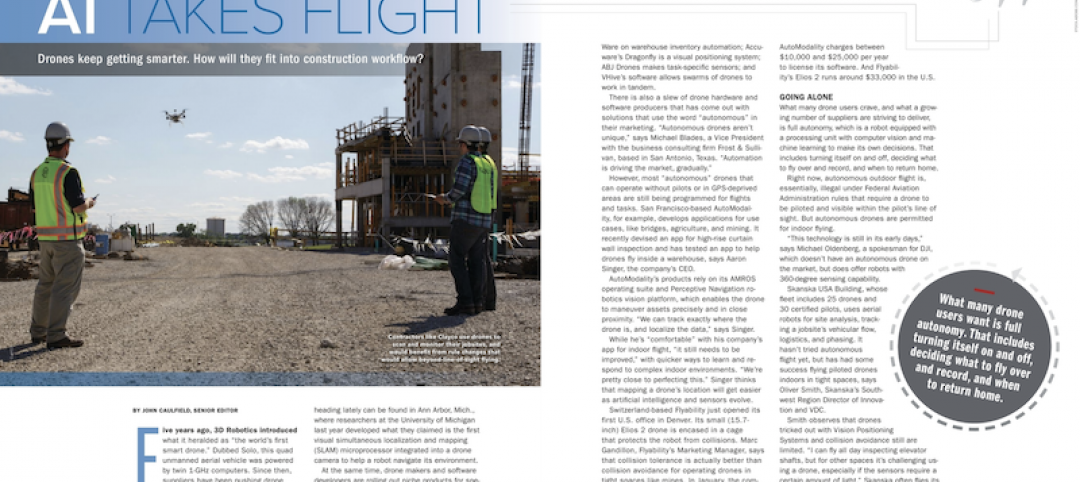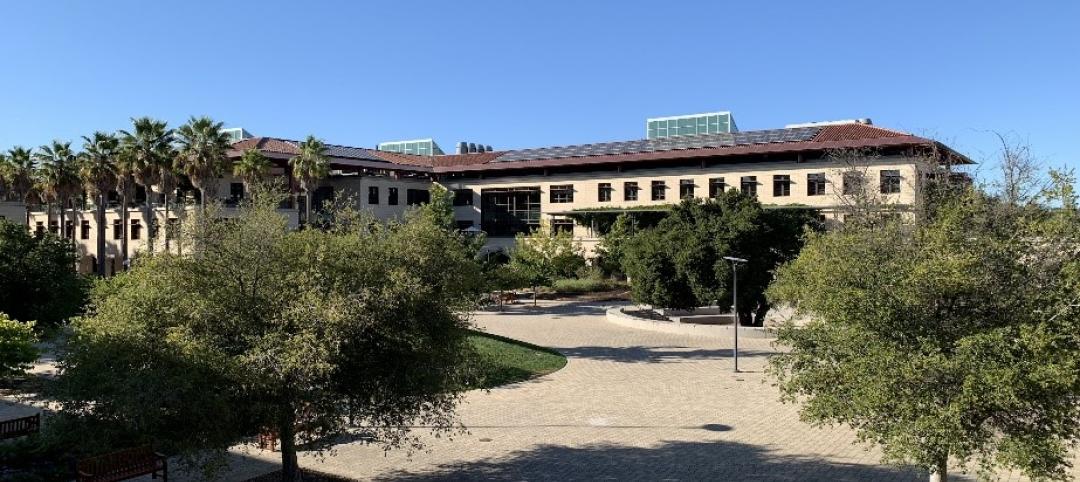The relationships between buildings and machines have always defined the fields of design and construction. More than 2,000 years ago, in the first treatise on architecture, Vitruvius dedicated all of the final volume to machines. Since then, arguably the entire history of construction has centered on the movement away from handicraft toward progressive degrees of mechanization. Today, mechanization, the replacement of hand labor, is increasingly giving way to automation, the replacement of human labor altogether.
Below are four fundamental relationships between buildings and machines. As automation becomes more prominent, it is changing these relationships dramatically.
Machines in Buildings
Over the past century or two, new mechanisms have fundamentally redefined the possibilities of buildings. After Elisha Otis invented the safety elevator in 1852, buildings could climb well beyond a comfortable walk-up height, and the skyscraper was born.
In 1902, Willis Carrier introduced modern air conditioning, which allowed floor plates to get deeper (spurring a century of energy hogging). The bimetallic thermostat, an example of automation dating from the 1880s, long has been a staple in homes and offices everywhere. Building automation systems (BAS) apply this concept systemwide, with internal feedback adjusting HVAC and lighting to improve comfort, security, energy consumption, maintenance, and operating costs.
The Internet of Things (IoT) connects computers embedded in everyday objects, including buildings, to expand these feedback loops beyond the immediate building to the entire world. Over the next few years alone, instances of IoT are expected to double in commercial real estate. Buildings are coming to be defined less as static objects and more as completely fluid environments.
Machines for Building
Ancient structures were assembled with a few simple tools, and the oldest may have used none at all. Possibly the earliest known “constructions,” during the Stone Age, were made of Mammoth bones lashed together to form huts. With the agricultural revolution, communities became less nomadic, and buildings became less portable, leading to heavier construction and the need for more powerful tools.
The industrial revolution catapulted whole industries and economies with mass-produced timber and steel. The history of construction since then has been propelled by leveraging more and more force, and today gigantic machines for digging and lifting dominate large construction sites.
But emerging automated techniques could return building fabrication to its origins in lightweight assembly methods. Homes are being 3D printed in 24 hours at a fraction of the expense of traditional construction. Bricklaying robots can assemble a wall at half the cost and 3-5 times the productivity. Soon, clouds of flying assembler drones could become the norm, making construction sites buzz and thrum like beehives or ant hills.
Buildings as Machines
“A house is a machine for living in,” Le Corbusier famously declared in 1929, and the mechanical metaphor became a foundational premise of modern architecture. Later, the machine aesthetic became more explicit. The Centre Pompidou in Paris (1977) wore its systems on its sleeve, the primary architectural expression coming from equipment, ductwork, and conveying systems.
But metaphor could soon become reality. Nanotechnology, originally proposed by Nobel physicist Richard Feynman half a century ago, manipulates individual atoms and molecules to build things—anything. Already, researchers have successfully experimented with nanotech in concrete and steel, strengthening materials and improving performance by adjusting automatically to offset stress and strain.
‘Buildings are coming to be defined less as static objects and more as
completely fluid environments.’ — Lance Hosey, FAIA, LEED Fellow, Gensler
Experts anticipate that within the next few decades, whole buildings could be fabricated using microscopic robots, which would join to make a cybernetic glue, eliminating traditional material constraints. Standard, irreducible components, such as the 2x4, the brick, and steel shapes, could be replaced by microscopic parts, and form, texture, color, and strength could be defined at the cellular level.
Orthogonal geometry, demanded for efficiency by standard frame construction, could disappear altogether. A century ago, Frank Lloyd Wright described “organic architecture” as “building the way nature builds.” Nanotech could finally bring this to fruition.
By modifying themselves over successive generations, ebbing and flowing in endless cycles of reproduction and adaptation, nano-assemblers could produce architecture through a process similar to genetic evolution—only faster—and therefore build exactly the way nature builds.
Buildings by and for Machines
In previous articles in this series, we’ve explored the implications of artificial intelligence. Futurist Ray Kurzweil predicts that machines will achieve human-level intelligence within a decade, and this will affect every industry, including our own.
If and when AI drives the entire process of design, construction, and operation, buildings could become exponentially smarter with resources, money, time, and performance, creating environments more engaging and comforting than we can imagine right now.
Yet, Kurzweil also anticipates that within a century we will concede that machines have legal and civil rights. Will self-aware buildings become as privileged as their inhabitants? How will our relationship with buildings change if we begin to see them as our equals? Machines could become more like us, but we could become more like them, as well.
Kurzweil is certain that artificial enhancements of the human body will become more common until we are more synthetic than organic. It will become possible to scan the mind and download it into more durable or flexible containers—such as buildings. Dwelling and dweller could become one and the same.
Lance Hosey, FAIA, LEED Fellow, is a Design Director with Gensler. His book, The Shape of Green: Aesthetics, Ecology, and Design, has been an Amazon #1 bestseller in the Sustainability & Green Design category.
Related Stories
AEC Tech | Oct 28, 2020
Meet Jaibot, Hilti's new construction robot
The semi-autonomous robot is designed to assist MEP contractors with ceiling-drilling applications.
Smart Buildings | Oct 26, 2020
World’s first smart building assessment and rating program released
The SPIRE Smart Building Program will help building owners and operators make better investment decisions, improve tenant satisfaction, and increase asset value.
AEC Tech | Oct 23, 2020
Risk mitigation: Seeing the forest and the tree
This case study highlights how new data analysis tools can be successfully leveraged to gain insights into some of the more abstract aspects of building evaluations.
Architects | Oct 14, 2020
The Weekly Show: AI for building facade inspections; designing a world-class architecture firm
The October 15 episode of BD+C's "The Weekly" is available for viewing on demand.
Smart Buildings | Oct 1, 2020
Smart buildings stand on good data
The coming disruption of owning and operating a building and how to stay ahead through BIM.
Digital Twin | Aug 27, 2020
The Weekly show: Digital twin technology and social equity in the AEC market
The August 27 episode of BD+C's "The Weekly" is available for viewing on demand.
AEC Tech | Apr 13, 2020
A robotic dog becomes part of Swinerton’s construction technology arsenal
Boston Dynamics, the robot’s creator, has about 100 machines in the field currently.
AEC Tech | Mar 30, 2020
Will 3D printing be an answer for building more affordable homes?
A project in southern California will put onsite fabrication to the test against other construction modes.
AEC Tech | Mar 23, 2020
Working from home? Don't miss out on the latest issue of Building Design+Construction
BD+C's March issue features the largest and most important technological innovations across the AEC industry.
AEC Tech | Mar 17, 2020
A tree grows in Stanford: CIFE, VDC, and where it all began
As our industry adopts VDC as standard practice, it is important to remember where these ideas began and continue to emanate from today.
















